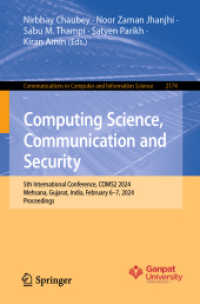- ホーム
- > 洋書
- > ドイツ書
- > Mathematics, Sciences & Technology
- > Earth Science
Full Description
This edited collection is based off work presented at the 15th International Conference on Military Geosciences (ICMG24), hosted by the Faculty of Military Sciences at Stellenbosch University. The goal of this publication is to compile and expand upon the research and discussions presented at the event, highlighting the integration of geosciences into military strategy and historical and contemporary operations. The book aims to serve as a comprehensive resource for researchers, practitioners and students engaged in the broad fields of geosciences, military studies, environmental science, historical geography, terrain analysis and related disciplines, offering a synthesis of current trends, methodologies, and applications critical to the advancement of military operations.
The edited collection seeks to enhance the scholarly and operational discourse on military geosciences overall by providing an avenue for the latest research, case studies, and theoretical insights. It intends to stimulate further investigation and encourage the practical application of military studies and geoscientific knowledge in military planning and decision-making. The book details how geoscientific understanding informs strategic advantage, operational efficacy, and risk mitigation in military contexts. It emphasizes terrain analysis, environmental considerations, geospatial intelligence, resource management, and the pivotal role of historical-geographical insights in shaping contemporary military strategies and operations.
By integrating authoritative research and analysis, this book contributes to the knowledge and professional development of its readers and prepares them to adeptly handle the intricacies of both present and future military challenges. Structured to document significant advancements, inspire cross-disciplinary collaboration, and enhance the application of geosciences in military contexts, it establishes itself as an essential educational resource, fostering a deeper comprehension and innovative application within the field.
Contents
Chapter 1: Thirty Years of Icmg Conference Series: History, Im-pact, Future Challenges And Opportunities.- Chapter 2: Influence of Geographical Factors On The Outcome of The Battle of The Blood River, South Africa, 16 December 1838.- Chapter 3: Application of Gis For Military Terrain Analysis: The Case of 'Black Week' (10-17 December 1899), Second Anglo-Boer War.- Chapter 4: 'Abomination of Desolation' Or 'God's Own Country': The Impact of The Environment And Terrain On Fighting South African Soldiers During The German South West African Campaign, C.1914-1915.- Chapter 5: Gordon Lyall Paver (1913-1988): Pioneer Of South African Military Geosciences And Groundwater Prospecting—Helping To Guide Terrain Use For Military Operations In World War.- Chapter 6: Snowed In: The Physical And Cultural Geography of The Winter War.- Chapter 7: "A New Way of Fighting": The South African Experience of Mountain Warfare in Italy, 1944-1945.- Chapter 8: Application of Geophysical Methods In German Armies During The First And Second World Wars.- Chapter 9: Battle Damage Assessment From Free And Open Source Satellite Imagery.- Chapter 10: Strengthening Resilience In The Global South: The Strategic Role Of Open Source Geospatial Technologies In Civil And Military Domains.- Chapter 11: Evolution of The Scope of Military Operations: The Emergence of Failed States And The Effective Sovereignty Doctrine.- Chapter 12: Why The Right Buzzwords Do Not Work In Africa's Emerging Geopolitical Frontiers.- Chapter 13: Comparative Geospatial Analysis of Urban Damage In Ukraine: Validating The Baei Through Temporal Change Detection.- Chapter 14: The First Climate War? An Environmental Security Analysis of The Darfur Conflict.- Chapter 15: A Geographic Analysis of The Shahi-Kot Valley As An Insurgent Safe Haven.- Chapter 16: Airborne Platforms For Gamma Emission Detection: Enhancing Radiological Surveillance In Military Geosciences.








